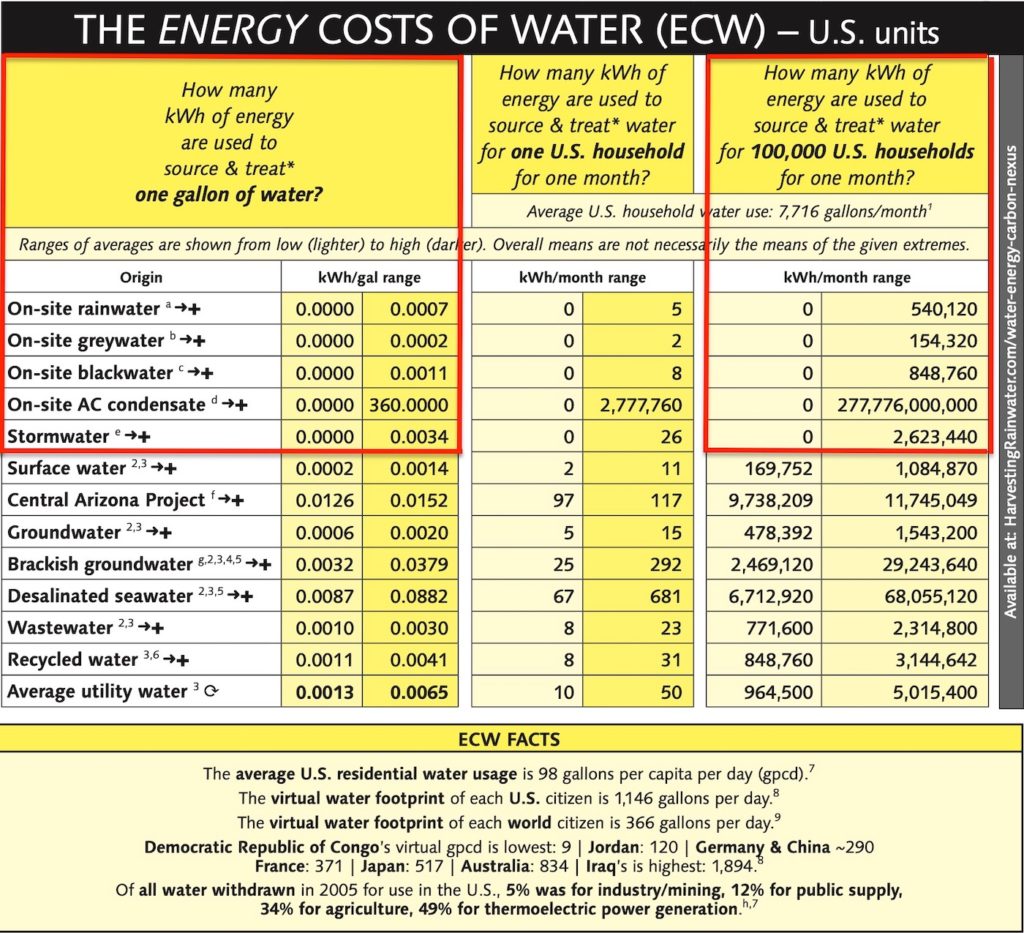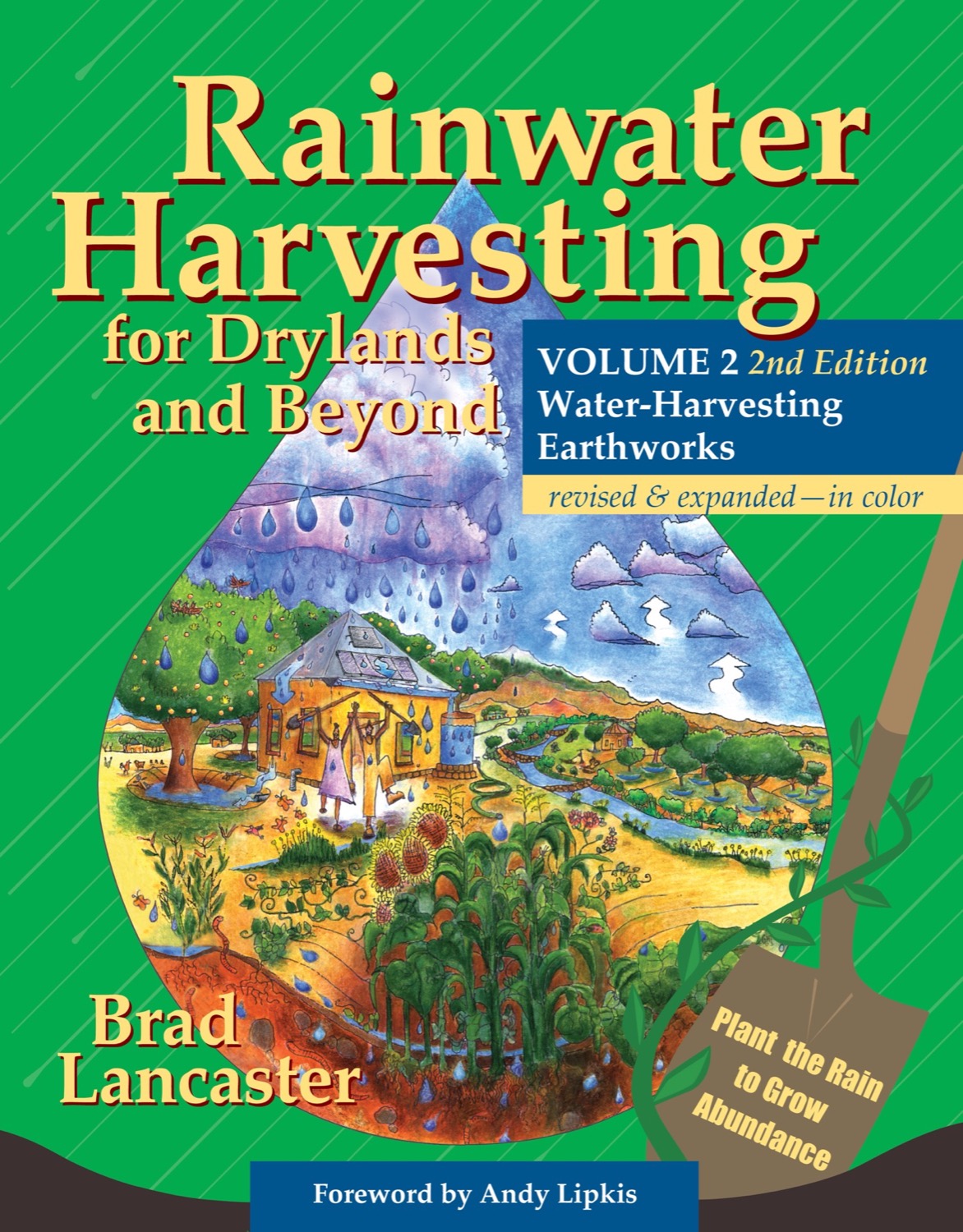Energy costs of condensate and other waters
The following chart shows you the energy costs (from pumping, transport, cooling, and/or treatment) of various sources of water…
Note the especially high end of the kWh/gallon range for on-site AC (air conditioning) condensate (an active condensate source). Active condensation occurs on mechanically cooled surfaces (surfaces cooler than the air temperature)—where a generated power source such as electricity is needed to cool the surface on which the atmospheric water (moisture in the air) condenses. Excerpted from Rainwater Harvesting for Drylands and Beyond, Volume 1, 3rd Edition.

Note the typically free on-site waters highlighted above within the red borders — especially AC condensate—, and how their energy costs can range from 0 kWh per gallon/liter to 360 kWh per gallon (95 kWh per liter). A kWh is a kilowatt hour of energy.
The average household in
Arizona consumes 1,095 kWh/month
U.S. consumes 920 kWh/month
World 250 kWh/month
The zero energy costs for various water sources reflected in the chart above typically result from harvesting those waters with no energy-consuming pumps or water treatment. Energy costs are incurred once pumps or mechanical water treatment is used. Or, in the case of AC condensate, the high energy cost does not reflect the use of pumps, but rather the large amount of energy the air conditioning unit itself consumes when on.
Due to the high-energy cost of the manufacture and use of air conditioning units (and their harmful chemical refrigerants – see next section), I don’t consider their condensate to be a truly sustainable on-site water source (even if renewable energy is the power source). But if air conditioners are already on site and used, you ought to at least harvest and use their condensate in beneficial ways, rather than just wastefully drain it away.
See appendix 9 of Rainwater Harvesting for Drylands and Beyond, Volume 1, 3rd Edition for charts and examples that show the water costs of different energy sources and the carbon costs of different energy sources in order to make more beneficial and informed choices in your life.
The refrigerant in air conditioners, refrigeration units, freezers, and ice machines is a major contributor to climate change
According the book Drawdown, the number one cause of climate changing gases in our atmosphere is the chemical refrigerants used in refrigerators and air conditioners.1
As reported in the book, Losing Our Cool: Uncomfortable Truths About Our Air-Conditioned World (and Finding New Ways to Get Through the Summer) by Stan Cox, “The air-conditioning of buildings in America is responsible for a quantity of carbon dioxide equivalent to what would be produced if every household in the country bought an additional vehicle and drove it an average 7,000 miles (11,200 km) per year.”2
This is horrifying due to the massive use and ever-expanding growth of the use of such appliances. But the main problem is not the appliances, but the chemical refrigerants used within them. And as history shows there is a path that could remedy this.
In the past, the chemical refrigerants (specifically chlorofluorocarbons [CFCs] and hydrochlorofluorocarbons [HCFCs] used to absorb and release heat) in refrigerators and air conditioners used to deplete the ozone layer of our atmosphere, and created massive holes (over entire countries) in the ozone layer. That ozone layer is essential for healthy life on our planet because it absorbs, and protects us from, the sun’s ultraviolet radiation.
Thanks to countries around the world agreeing to, and signing, the 1987 Montreal Protocol on Substances That Deplete the Ozone Layer; CFCs, HCFCs, and other ozone-depleting chemicals such as those that used to be used in aerosol cans and dry cleaning; have been phased out of use. As stated in the book Drawdown, “It took two short years from the discovery of the gaping hole (in the ozone layer) over the Antarctic for the global community to adopt a legally mandated course of action. Now, three decades later, the ozone layer is beginning to heal.”3
The replacement chemical refrigerant to CFCs and HCFCs, is primarily hydrofluorocarbons (HFCs), which does not destroy the ozone layer, but HFCs’ capacity to warm the atmosphere is one thousand to nine thousand times greater than that of carbon dioxide!4
As Drawdown states, “In October 2016, officials from more than 170 countries gathered in Kigali, Rwanda, to negotiate a deal to address the problem of HFCs. Despite challenging global politics, they reached a remarkable agreement. Through an amendment to the Montreal Protocol, the world will begin phasing HFCs out of use, starting with high-income countries in 2019 and then expanding to low-income countries — some in 2024, others in 2028. HFC substitutes are already on the market, including natural refrigerants such as propane and ammonium.”5
The Kigali Amendment took effect January 2019, and over 65 countries have ratified the agreement,6 but as of this writing the U.S. is not one of them.7 Though on January 27, 2021 President Biden took the first steps for U.S. ratification.8
Take action
Communicate to your politicians and policy makers the importance of ratifying the Kigali Amendment; and make changes in your own lives, by reducing or eliminating your reliance on, and use of, appliances using HFC refrigerant (Rainwater Harvesting for Drylands and Beyond, Volume 1, 3rd Edition gives you many strategies to do this), and dispose of the refrigerant in a way that will keep it out of the atmosphere (Construction and Demolition: How to Properly Dispose of Refrigeration and Air-Conditioning Equipment, https://www.epa.gov/sites/production/files/documents/ConstrAndDemo_EquipDisposal.pdf, U.S. Environmental Protection Agency, accessed 11-1-2019).
References:
1. Paul Hawken – editor, Drawdown: The Most Comprehensive Plan Ever Proposed to Reverse Global Warming, Penguin Books, 2017)
2. Stan Cox, Losing Our Cool: Uncomfortable Truths About Our Air-Conditioned World (and Finding New Ways to Get Through the Summer), (The New Press, 2010), page 41.
3. Paul Hawken – editor, Drawdown: The Most Comprehensive Plan Ever Proposed to Reverse Global Warming, Penguin Books, 2017)
4. Paul Hawken – editor, Drawdown: The Most Comprehensive Plan Ever Proposed to Reverse Global Warming, Penguin Books, 2017)
5. Paul Hawken – editor, Drawdown: The Most Comprehensive Plan Ever Proposed to Reverse Global Warming, Penguin Books, 2017)
6. “Kigali Amendment Enters into Force, Bringing Promise of Reduced Global Warming,” by Faye Leone, SDG Knowledge Hub, January 9, 2018, https://sdg.iisd.org/news/kigali-amendment-enters-into-force-bringing-promise-of-reduced-global-warming/, accessed 11-1-2019
7. “What’s Keeping Trump from Ratifying a Climate Treaty Even Republicans Support?,” by Phil McKenna, Inside Climate News, February 12, 2019, https://insideclimatenews.org/news/12022019/kigali-amendment-trump-ratify-hfcs-short-lived-climate-pollutant-republican-business-support-montreal-protocol, accessed 11-1-2019
8. “Biden Announces Move to Ratify Kigali Amendment on HFCs,” by Alex Hillbrand and David Doniger, NRDC Expert Blog, January 27, 2021, https://www.nrdc.org/experts/alex-hillbrand/biden-announces-move-ratify-kigali-amendment-hfcs, accessed 2-5-2021
For more
See Rainwater Harvesting for Drylands and Beyond, Volume 2, 2nd Edition

